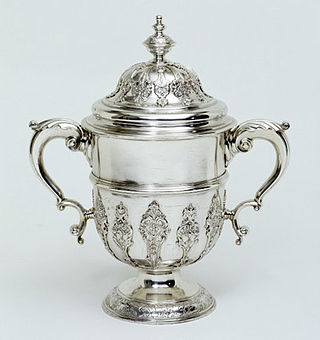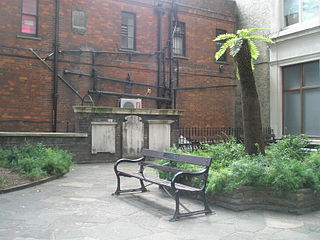Related Research Articles

Paul Jacques de Lamerie was a London-based silversmith. The Victoria and Albert Museum describes him as the "greatest silversmith working in England in the 18th century". He was being referred to as the "King's silversmith" in 1717. Though his mark raises the market value of silver, his output was large and not all his pieces are outstanding. The volume of work bearing de Lamerie's mark makes it almost certain that he subcontracted orders to other London silversmiths before applying his own mark.

The Lord Warden of the Cinque Ports is a ceremonial official in the United Kingdom. The post dates from at least the 12th century, when the title was Keeper of the Coast, but may be older. The Lord Warden was originally in charge of the Cinque Ports, a group of five port towns on the southeast coast of England that was formed to collectively supply ships for The Crown in the absence at the time of a formal navy. Today the role is a sinecure and an honorary title, and fourteen towns belong to the Cinque Ports confederation. The title is one of the higher honours bestowed by the Sovereign; it has often been held by members of the Royal Family or prime ministers, especially those who have been influential in defending Britain at times of war.

The Trial of the Pyx is a judicial ceremony in the United Kingdom to ensure that newly minted coins from the Royal Mint conform to their required dimensional and fineness specifications. Although coin quality is now tested throughout the year under laboratory conditions, the event has become an annual historic tradition. Each year, thousands of coins are put on trial, consisting of both those struck for circulation and non-circulating commemorative coins.

Goldsmiths' Hall is a Grade I listed building at the junction of Foster Lane and Gresham Street in the City of London. It has served as an assay office and the headquarters of London's goldsmith guild, the Worshipful Company of Goldsmiths, one of the livery companies of the City of London. The company has been based at this location since 1339, the present building being their third hall on the site.

Lullingstone Castle is a historic manor house, set in an estate in the village of Lullingstone and the civil parish of Eynsford in the English county of Kent. It has been inhabited by members of the Hart Dyke family for twenty generations including current owner Tom Hart Dyke.

Sir Edmund Shaa or Shaw was a London goldsmith, Sheriff of London in 1475 and Lord Mayor of London in 1482. Shaa lent money to Edward IV and, as mayor, was extensively involved in the coronation of Edward IV's brother Richard III. He was later knighted and made a member of the Privy Council.

Farringdon Within is one of the 25 wards of the City of London, the historic and financial centre of London, England. It was formed in the 14th century from the sub-division of the pre-existing Farringdon Ward into Farringdon Within, and Farringdon Without, beyond the Wall.

Farringdon Without is the most westerly Ward of the City of London, England. Its suffix Without reflects its origin as lying beyond the City's former defensive walls. It was first established in 1394 to administer the suburbs west of Ludgate and Newgate, including West Smithfield and Temple. This was achieved by splitting the very large, pre-existing Farringdon Ward into two parts, Farringdon Within and Farringdon Without. The large and prosperous extramural suburb of Farringdon Without has been described as having been London's first West End.
Robert Amadas was a London Goldsmith whose clients included King Henry VIII and his courtiers. He was Master of the King's Jewel House, and one of the Deputy Masters of the Mint.

St Peter, Westcheap, also called "St Peter Cheap", "St Peter at the Cross in Cheap", or "Ecclesia S. Petri de Wodestreet", was a parish and parish church of medieval origins in the City of London. The church stood at the south-west corner of Wood Street where it opens onto Cheapside, directly facing the old Cheapside Cross. In its heyday it was a familiar landmark where the City waits used to stand on the roof and play as the great processions went past. It was destroyed in the Great Fire of London in 1666, together with most of its surroundings, and was never rebuilt.
Sir Richard Martin was an English goldsmith and Master of the Mint who served as Sheriff and twice as Lord Mayor of the City of London during the reign of Elizabeth I.

Sir Martin Bowes was a very prominent and active civic dignitary of Tudor London whose career continued through the reigns of Henry VIII, Edward VI, Mary I and Elizabeth I. Born into the citizenry of York, Bowes was apprenticed in London and made his career at the Royal Mint, as a master-worker and under-treasurer, and personally implemented the debasement of English currency which became a fiscal imperative in the later reign of Henry.
Sir James Pemberton was an English goldsmith who was Lord Mayor of London in 1611.

John Lonyson or Lonison (1525–1582) was an English goldsmith and Master of the Mint in the reign of Elizabeth I.
Sir John Shaa or Shaw was a London goldsmith. He served as engraver and later joint Master of the Mint, and as Sheriff and Lord Mayor of London. While Lord Mayor he entertained ambassadors from Scotland, and was among those who welcomed Catherine of Aragon to England. He is mentioned in a poem by William Dunbar.

Sir Thomas Vyner, 1st Baronet was an English merchant and politician who served as the Lord Mayor of London in 1653. Vyner supplied gold bullion to two English kings and to the Protectorate of Oliver Cromwell. Born at North Cerney, Gloucestershire, on 15 December 1588, Vyner was the son of Thomas and Anne Vyner. After his father's death in 1600, Vyner was sent to London to live with his sister and brother-in-law, Samuel Moore.
Henry le Walleis was a 13th-century English politician and Mayor of London. His origins are obscure; he was an outsider to London and may have been Welsh by birth. After making his fortune in the wine trade, he became an alderman in 1269 and sheriff in 1270. As alderman, he represented the ward of Cordwainer. He went on to serve five terms as mayor.
Walter Hervey was a 13th-century English Lord Mayor of London. He was elected mayor in the waning days of the reign of Henry III, while the heir apparent was away on a crusade in the Holy Land. At the time of his election, there was an ongoing rivalry between the common citizens of London and the city's aldermen. The aldermen proposed Philip le Tayllor as the new mayor, but a large portion of the citizenry installed Hervey as mayor over their objections. During his term, Hervey signed charters for the various crafts, in effect creating an early form of trade unions. After his term as mayor was ended, Hervey was succeeded by Henry le Walleis. Walleis, along with his political ally Gregory de Rokesley, nullified the charters. Although Hervey attempted to rally his followers to preserve the charters, his efforts were in vain. With royal backing, Henry le Walleis had Hervey formally arraigned on a variety of charges, and ultimately Hervey was hounded out of his office as alderman and forbidden to ever again take part in the governance of the city. After this, there is little record of Walter Hervey, other than that he had a daughter, Anne, who married Thomas Woodchurch.
Sir Bartholomew Reade was an English goldsmith and politician who served as Lord Mayor of London.
Sir Arnold Savage, Lord of Bobbing, was a 14th century English knight and administrator from the Savage family, who was a commissioner of array in Kent (1346), lieutenant of the Seneschal of Gascony (1350), sat in the parliament of January 1352, Warden of the Coasts of Kent (1355), Mayor of Bordeaux (1359-63), and was employed in negotiations between England and Castile and France.
References
- ↑ Lee, Sidney, ed. (1897). . Dictionary of National Biography . Vol. 49. London: Smith, Elder & Co.
- ↑ The history of the twelve great livery companies of London, Herbert, 1836
- ↑ "Gregory de Rokesley blue plaque".